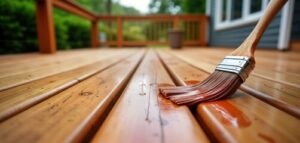How to Stain a Deck
As the weather warms up, many homeowners want to get their outdoor projects started. One popular project is staining the deck.
Staining the deck is a time-consuming task that should be done properly. It’s important to ensure that the wood is in good condition, including repairing cracks and splinters. It’s also necessary to prepare the deck for staining, including cleaning and sweeping. Contact Deck Builders Baltimore County for professional help.
Whether your deck is new or old, it will need to be prepped and cleaned before you can stain. This may mean a simple power wash, or you may need to strip it. In any case, the wood should be completely dry before you begin.
Ensure that all furniture and plants are moved away from the decking, as well as any outdoor structures such as sheds. Then, use a stiff brush to sweep away any loose leaves or debris and dirt. You will also need to remove any nails or screws that have been nailed into the boards. This will allow you to get a clean and even surface without any marks or holes.
The next step is to decide what type of stain you want. There are several different options, including water-based and oil-based stains. Water-based stains are usually recommended for redwood or cedar, because they offer excellent resistance to rot and decay. Oil-based stains, on the other hand, are designed to penetrate into the pores of the wood, which allows for a richer color and more natural appearance. Regardless of which type of stain you choose, it is important to test it on a hidden area of the deck to make sure that it has the desired color and feel before applying it to the whole surface.
You should also decide whether you are going to apply the stain with a roller or a paint sprayer. In either case, you will need a brush to help cut in corners and other trim areas as well as to back-brush the stain and work it deeper into the pores of the wood. This will ensure that the stain is fully saturated and protected from UV damage and weathering.
It is also recommended that you try to stain the deck in the early morning or late afternoon, when the sun will not be beating down directly on the surfaces. This will prevent the stain from drying too quickly and will give you the most time to blend in lap marks and achieve an even and balanced application.
Tools
When it comes to staining a deck, there are a variety of tools you can use. Whether you’re doing the job yourself or working with a professional, understanding what tools are needed can help you get the best results possible. Using the right tools will help ensure that your deck is evenly stained and looks great for years to come.
The best tool for the job depends on the type of stain and wood texture. For example, oil-based stains require brushes that are designed to work with the wood grain and provide good coverage. Similarly, water-based stains can be applied with brushes, rollers, pads or sprayers. Aside from choosing the right tools for your specific project, it’s important to use the proper technique. This can help you avoid common issues such as splatter, uneven absorption and color streaking.
A quality brush provides consistent coverage, allowing you to easily paint narrow gaps or hard-to-reach areas. They are also ideal for working stains deep into the wood’s grain and are suitable for most wood types. Depending on the stain type, brush application can be faster than other methods.
If you’re restoring an old deck, it may be necessary to strip the surface of the wood before staining. This will remove mildew, dirt and other surface debris that can prevent the new stain from adhering properly. Once the deck is stripped and cleaned, it’s important to allow the wood to dry completely before applying a fresh coat of stain.
Before you start staining, it’s a good idea to read the product label to determine how much stain is needed and recommended application methods. The label will also tell you what outdoor temperature ranges are appropriate and how long the stain will take to dry.
Staining your deck is an excellent way to protect the wood from the elements and add curb appeal to your home. It’s a relatively easy project that can be completed in just a few days. Staining your deck regularly will ensure that it stays in top condition for years to come.
Applying the Stain
A deck stain helps prevent moisture from soaking into the wood, which can cause mold or mildew growth and make the deck unsafe to walk on. Stain also protects the wood from rot and extends its lifespan by adding an extra layer of protection to the surface. Staining the deck every two to three years is a great way to keep it looking new and protect against the elements.
Before you can begin the application process, it’s important to have a plan of action and know what type of stain you want to use. Start by determining whether you are using an oil-based or water-based stain. Water-based stains contain lower amounts of volatile organic compounds (VOCs) and offer a variety of tint options, while oil-based stains are available in more limited colors. It’s important to follow the stain’s instructions for proper prep and application.
Start the application process by sweeping and pressure washing the deck, if needed. During the power wash, be sure to use caution and do not apply too much pressure as it can damage the deck wood. Then, allow the deck to dry completely. Next, you will need to decide if you are going to apply a solid stain or a semi-transparent stain. Solid stains provide a deep color that sits on the surface of the wood. They are available in a variety of tones and opacities and are able to provide additional UV protection compared to a sealer.
Semi-transparent stains are a bit more challenging to apply, but they allow the natural wood grain to show through and give you a range of different colors. Water-based semi-transparent stains are easier to work with and offer longer color retention than oil-based ones.
If you’re applying a semi-transparent or transparent stain, then it is recommended that you back brush the wood to smooth out the application and to avoid lap marks. Lastly, be sure to cover adjacent surfaces and furniture with painter’s tape to protect them from overspray and drips. After the application is complete, let the stain dry for a minimum of 24 hours before you can return your furniture to the deck.
Finishing
After the stain has dried, it’s time to get your furniture back on the deck. Wait 24-48 hours for the deck to dry completely before walking on it or placing furniture on it. Be sure to store any unused stain in a cool, dry area.
There are many different types of wood stains, including oil-based and water-based. Water-based stains are low in VOCs (volatile organic compounds) and require soap and water for cleaning, making them a safer choice for the environment than oil-based stains. They also dry faster and offer better moisture protection than their oil-based counterparts.
Transparent and semi-transparent stains allow the wood grain to be seen while adding color and providing moderate protection against the elements, especially UV light. They are best for newer decks, or decks that have been recently resurfaced and are still in good shape, but need a little extra protection to prolong their life.
Solid stains are opaque and hide the wood grain, providing a more painted look for your deck. They are available in a wide variety of colors and are the best choice for older or well-used decks that need to be covered in order to protect it from the weather, but want to maintain their natural beauty.
The process of applying wood stain to your deck can be done by spraying, rolling or using a paintbrush. It’s a good idea to use a natural bristle brush, as this will help work the stain into the pores of the board and ensure that all areas are evenly coated. Regardless of how you choose to apply the stain, be sure to back-brush it while it’s wet to help it penetrate deeper into the boards and avoid lap marks.
Once the stain has been applied, you’ll need to let it dry according to the manufacturer’s instructions. If possible, try to apply the stain in a shaded area so that it doesn’t dry in direct sunlight, which can cause streaking and discoloration. Before you begin, it’s also a good idea to test the color and finish of the stain on a small, hidden area of your deck so that you can be sure it meets your expectations.






